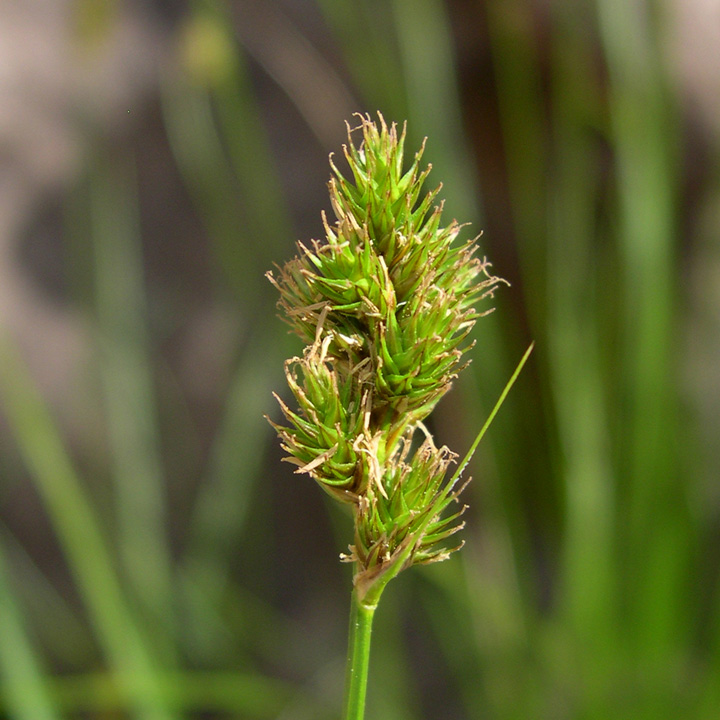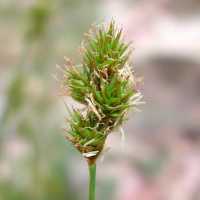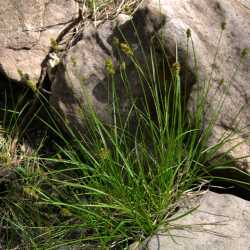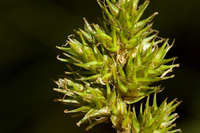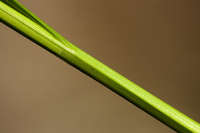Plants densely cespitose. Culms 20-104 cm. Leaves: sheath white-hyaline, summits usually U-shaped, sometimes rounded and prolonged to 3 mm beyond collar; distal ligules 1-3(-6) mm; blades 3-5(-8) per fertile culm, 6-45 cm × 1.2-3(-3.7) mm. Inflorescences open or dense, green to brown, 1.1-3 cm × 5.4-16.3 mm, appearing fine-textured; proximal internode (1.5-)2.5-9.5 mm; 2d internode 1-3(-6) mm; proximal bracts scalelike or bristlelike shorter than inflorescences. Spikes 4-11(-14), densely or loosely aggregated, broadly ovoid to ovoid, 5-11 × 2.7-7.1 mm, base rounded or acute, apex usually rounded. Pistillate scales usually white-hyaline or hyaline gold, occasionally chestnut to dark brown, with pale to green midstripe, ovate to broad-ovate, 2.1-3.5(-3.9) mm, shorter than or ± covering perigynia, margin white, 0-0.2 mm wide, apex obtuse to acuminate. Perigynia ascending to spreading, green, straw colored to light brown, or whitish, conspicuously (0-)2-8(-11)-veined abaxially, conspicuously 0-6-veined adaxially, veins thick, reaching, not extending beyong top of achene, lance-ovate to ovate, plano-convex, 2.4-4(-4.3) × 0.9-1.9 mm, 0.4-0.5(-0.6) mm thick, 2.1-2.7 times as long as wide, margin flat, including wing 0.15-0.3(-0.45) mm wide, ciliate-serrulate at least on distal body; beak green, gold, brown or white-hyaline at tip, flat, ± ciliate-serrulate or cylindric, unwinged, ± entire for 0.4-0.7 mm, abaxial suture usually inconspicuous, distance from beak tip to achene 1.2-2 mm. Achenes elliptic to quadrate, 1-1.6 × 0.7-1.25 mm, (0.3-)0.4-0.5(-0.6) mm thick. 2n = 84.
Fruiting summer. Seasonally moist mountain meadows, along watercourses; 100-3500 m; Ariz., Calif., Idaho, Nev., N.Mex., Oreg., Utah, Wash.; Mexico (Baja California); Pacific Islands (Hawaii).
Common Name: brown sedge
Duration: Perennial
Nativity: Native
Lifeform: Graminoid
General: Densely tufted perennial with stems 20-100 cm, without creeping rhizomes.
Vegetative: Leaves borne on lower part of stem, summits u-shaped, sheaths white-hyaline, sometimes rounded and prolonged to 3 mm beyond collar, 3-5 blades per fertile stem, 6-45 cm long and 1-3 mm wide.
Inflorescence: Densely to loosely aggregated with 4-11 spikes, broadly ovoid to ovoid, 1-3 cm long by 5.5-16 mm wide, green to brown, appearing fine textured; bracts at base of inflorescence scale like or bristlelike and shorter than inflorescence; pistillate scales white-hyaline or gold, ovate to broad ovate 2-3.5 mm, shorter than perigynia, margin white with obtuse to acuminate apex; perigynia ascending to spreading, green to straw colored or light brown and whitish, conspicuously 2-8 veined below, lance-ovate to ovate, plano-convex 2.5-4 mm long by 1-2 mm wide, margin flat, ciliate-serrulate on upper body, beak green to gold brown, flat; achenes elliptic to quadrate, 1-1.6 mm long.
Ecology: Found in seasonally moist meadows or along streams from 3,500-9,500 ft (1067-2896 m); flowers May-August.
Notes: This is perhaps the most common sedge in Arizona, existing over a wide elevational range and in a variety of wet habitats. Its inflorescence ranges from a more tightly clustered head of spikes, to one moderately elongate and irregular. It has small, plano-convex perigynia that are narrowly winged and veined, and when mature are substantially filled by the achene. It is most easily confused with Carex athrostachya, another sedge in the Ovales section, that typically has the majority of inflorescences on a plant with the first 2-3 inflorescence bracts leaflike and surpassing the head. Carex subfusca sometimes exhibits the trait of having long inflorescence bracts although not as frequently or regularly, but often enough to have caused much confusion in the past. The perigynia of Carex athrostachya are a little more elongate and flatter, and not filled so fully by the achene when mature. There are a number of other Ovales species in northern Arizona at higher elevations that are similar, but none that have been found yet in the Sonoran Desert Network. (Notes: Max Licher and Glenn Rink 2012)
Ethnobotany: Unknown
Etymology: Carex is the classical Latin name for the genus, while subfusca means darkish or brownish.
Synonyms: Carex macloviana subsp. subfusca, Carex stenoptera, Carex agrostoides
Editor: SBuckley, 2010


